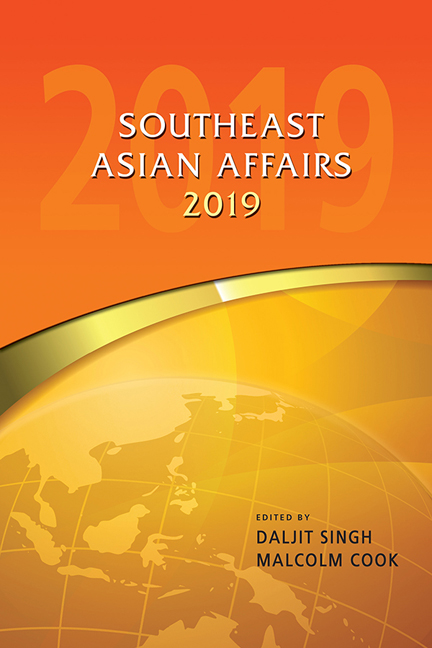Book contents
- Frontmatter
- Contents
- Introduction
- THE REGION
- Challenges to Southeast Asian Regionalism in 2018
- Regional Integration in Asia and the Pacific, and Dealing with Short and Long Term Challenges
- Looking West, Acting East: India's Indo-Pacific Strategy
- An Australian Vision of the Indo-Pacific and What It Means for Southeast Asia
- The Trump Administration's Free and Open Indo-Pacific Approach
- Japan's “Free and Open Indo-Pacific Strategy” and Its Implication for ASEAN
- BRUNEI DARUSSALAM
- CAMBODIA
- INDONESIA
- LAOS
- MALAYSIA
- MYANMAR
- THE PHILIPPINES
- SINGAPORE
- THAILAND
- TIMOR-LESTE
- VIETNAM
An Australian Vision of the Indo-Pacific and What It Means for Southeast Asia
from THE REGION
Published online by Cambridge University Press: 07 September 2019
- Frontmatter
- Contents
- Introduction
- THE REGION
- Challenges to Southeast Asian Regionalism in 2018
- Regional Integration in Asia and the Pacific, and Dealing with Short and Long Term Challenges
- Looking West, Acting East: India's Indo-Pacific Strategy
- An Australian Vision of the Indo-Pacific and What It Means for Southeast Asia
- The Trump Administration's Free and Open Indo-Pacific Approach
- Japan's “Free and Open Indo-Pacific Strategy” and Its Implication for ASEAN
- BRUNEI DARUSSALAM
- CAMBODIA
- INDONESIA
- LAOS
- MALAYSIA
- MYANMAR
- THE PHILIPPINES
- SINGAPORE
- THAILAND
- TIMOR-LESTE
- VIETNAM
Summary
The concept of the Indo-Pacific plays a role of growing importance in the way the world is coming to terms with China's power and assertiveness. This concept serves two related purposes: an objective definition of an Asia-centric strategic and economic system, spanning a two-ocean region and replacing the late-twentiethcentury idea of the Asia-Pacific, and the foundation for a strategy of incorporating and diluting Chinese power within a multipolar order reflecting respect for rules and equal sovereignty. No one country or strategic thinker can lay claim to the rapid emergence of this concept. In fact, the Indo-Pacific is not such a new idea, with precursors of pan-Asian maritime connectivity going back to pre-colonial times. Moreover, a sense of this revived regional construct emerged through a process of interaction among policy establishments and strategic thinkers in a number of nations, including Australia, India, Japan, the United States and Indonesia, in the first two decades of the twenty-first century.
It is notable, however, that Australia has been the most prominent and active proponent of this concept. Australia was the first country to formally introduce the Indo-Pacific as the official definition of its strategic environment in 2013. This has consistently been reaffirmed since, and elaborated in the 2017 Foreign Policy White Paper that provides a vision for Australia's international relations. It is fair to say that the Indo-Pacific is now bipartisan orthodoxy in Australia. A likely change to a Labor government in 2019 is unlikely to shift this perspective.
Some critics of the Indo-Pacific idea assume that it is essentially a “madein- America” concept designed with the principal purpose of containing or at least balancing Chinese power. In fact, a closer look at Canberra's version of the Indo- Pacific, most formally articulated in the Foreign Policy White Paper, suggests it has some authentically Australian characteristics, such as its encouragement of agency and cooperation among smaller and middle powers. This places it within the tradition of Asian engagement and creative middle power diplomacy as espoused by Australian Labor governments in decades past. Moreover, such a reading of Australia's “new” Indo-Pacific strategy makes it suited for convergence with the imperatives of partner countries in Southeast Asia, and indeed with the Association of Southeast Asian Nations (ASEAN) as a whole.
- Type
- Chapter
- Information
- Southeast Asian Affairs 2019 , pp. 53 - 60Publisher: ISEAS–Yusof Ishak InstitutePrint publication year: 2019



